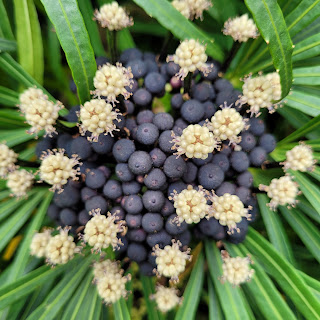The Greendale State of Things
Written by: Pamela Ooi, Class 2E2
Located opposite the Design, Technology and Engineering (DTE) lab is our school garden. It is a place that is packed with rich biodiversity and many different types of plants. One of them is the Sansevieria cylindrica, also known as the cylindrical snake plant. It is a succulent plant native to Angola. This unique plant has striped, elongate, smooth, greenish-grey subcylindrical leaves. This species of plant is interesting in having subcylindrical instead of strap-shaped leaves caused by failure to express genes that would cause the cylindrical bud to differentiate dorsoventrally or produce a distinctive and familiar top and bottom surface to the leaf blade.
Sansevieria cylindrica
Photo: Andrea M. "Steam" Rivolta (via worldofsucculents.com)
Photo: Andrea M. "Steam" Rivolta (via worldofsucculents.com)
Another interesting plant is Vitex trifolia. Vitex trifolia, also known as the simpleleaf chaste tree, is commonly used in traditional Chinese medicine and described by 'Shen Nong’s Herbal Classic' as one of the supreme Chinese herbs. Traditionally, it is considered a herb that is good at alleviating fever, helping mucus for easier expulsion, lowering blood pressure, inhibiting the reproduction of viruses, and so on. That’s to say, it treats a wide range of diseases, including the common cold, prosopalgia, chronic tracheitis, sinusitis, periodontitis, rheumatism, and more.
Vitex trifolia
Photo: MR (via toptropicals.com)
Photo: MR (via toptropicals.com)
If you take a peek under the wooden tables near the DTE lab, you will be able to find bagworms. These harmless creatures build small protective cases in which they can hide. The bagworms belong to the superfamily Tineoidea, which is a basal lineage of the Ditrysia just as the Gelechioidea, in which the case-bearers were placed. This means that the bagworms and case-bearers are only as closely related to each other as either is to butterflies. They will eventually turn into moths in late summer or early autumn to begin their quest for a mate.
Photo: Pamela Ooi
There are also many tiny creatures hiding among the bushes like the Zootoca vivipara. Something interesting about these common lizards is that they give live birth instead of laying eggs. Both the genus name 'Zootoca' and species name 'vivipara' mean “live birth”, in Greek and Latin respectively. Be extra quiet when you approach them as they are very timid.
Zootoca vivipara
Photo credit: Josef Hlasek
Besides all of the above mentioned, nature conservation is also an important factor that we need to take into consideration. We can be smarter about how we use our oceans, freshwater and land, and how we produce energy, food and other resources.
We have the knowledge and capability to move towards a better future for people and nature. And we’re already exploring new ways to feed our growing population, meet our energy demands and manage our water supply.
Now is the time to get behind these solutions to ensure that everyone gets a fair share without destroying nature.
'Our environment, our responsibility, our future.' – Christopher Voekel





Comments
Post a Comment